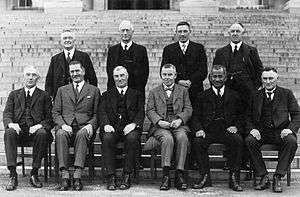United-Reform Coalition
United-Reform Coalition | |
|---|---|
| Leader | George Forbes |
| Deputy Leader | Gordon Coates |
| Founded | September 1931 |
| Dissolved | 14 May 1936 |
| Merger of |
United Party Reform Party |
| Merged into | National Party |
| Ideology |
Conservatism Classical liberalism |
| Political position | Centre-right |
The United-Reform Coalition, also known as the National Political Frederation from 1935,[1] was a coalition between two of the three major parties of New Zealand, the United and Reform parties, from 1931-1936. The Coalition formed the Government of New Zealand from its formation in September 1931, successfully contesting and winning the 1931 general election in December. The Coalition was defeated at the 1935 general election by Labour. The following year the coalition was formalised by the formation of the modern New Zealand National Party.
Primarily the coalition was formed to deal with the Great Depression which began in 1929. The Labour Party refused to join the coalition, as it believed that the only solution to the depression was socialism.
History
Formation

Front row (L-R): Ransom, Coates, Forbes, Stewart, Ngata and Young.
Back row (L-R): Jones, Cobbe, Hamilton and Masters.
The initial coalition between United and Reform had formed in September 1931,[2] following the collapse of an earlier coalition between United and Labour. Fearing that splitting the anti-Labour vote would result in a Labour government even if it received fewer votes than United and Reform combined, the two centre-right parties formed a coalition and an election agreement. Part of the agreement was that all sitting members who support the coalition would in turn receive the official endorsement as coalition candidate. This pragmatic decision caused trouble in those electorates where the voters were not satisfied with the incumbent's performance, for example in the Wairarapa and Otaki electorates.[3]
In the subsequent election, the coalition won 54.0% of the popular vote, compared to 34.3% for Labour.
Defeat
The government focused primarily on getting New Zealand out of the depression by cutting government spending and thus balancing the national budget. It dealt with widespread unemployment by initiating relief work, which involved compelling the unemployed to work on a range of projects ranging from useful public works to pointless activity. The government was widely seen as heartless, encapsulated by the commonly believed but probably untrue story that Prime Minister George Forbes had told a delegation of unemployed men to go and eat grass. In the 1935 election, Labour won 46.1% of the popular vote, while the coalition won only 32.9%. However the result in terms of seats was an electoral wipeout, with Labour winning 53 seats to the coalition's 16. A further eleven seats were won by minor parties and independents. Following their defeats, the United and Reform parties merged to become the National Party.
Electoral results
| Election | # of votes | % of vote | # of seats won | Government/opposition? |
|---|---|---|---|---|
| 1931 | 386,040 | 54.03 | 51 / 80 | Government |
| 1935 | 285,422 | 33.48 | 19 / 80 | Opposition |
See also
Notes and references
Citations
- ↑ Gustafson 1986, p. 4.
- ↑ "Coalition Announced". The New Zealand Herald. LXVIII (20982). 19 September 1931. p. 10. Retrieved 25 November 2014.
- ↑ "Hints of Trouble". The Evening Post. CXII (106). 31 October 1931. p. 12. Retrieved 25 December 2014.
References
- Gustafson, Barry (1986). The First 50 Years : A History of the New Zealand National Party. Auckland: Reed Methuen. ISBN 0-474-00177-6.
- Bassett, Michael (1982). Three Party Politics in New Zealand 1911-1931. Auckland: Historical Publications. ISBN 0-86870-006-1.